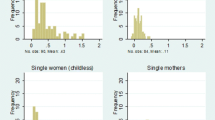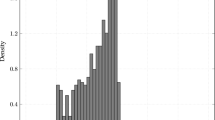Summary
This paper performs a meta-analysis of empirical estimates of uncompensated labour supply elasticities. For the Netherlands, we find that an elasticity of 0.5 for women and 0.1 for men is a good reflection of what the literature reveals. The elasticity for men hardly differs between countries, but for women some cross-country variation is found. The increasing participation rate of women may lead to a somewhat lower elasticity in the future. Both the specification of the hours function and the estimation method are found to affect elasticity estimates.
Article PDF
Similar content being viewed by others
Avoid common mistakes on your manuscript.
References
Alesina, A., E. Glaeser and B. Sacerdote (2005), ‘Work and Leisure in the U.S. and Europe; Why so different,’ NBER Working Paper no. 11278.
Arellano M., Meghir C. (1992) ‘Female Labour Supply and on the Job search: An Empirical Model Estimated Using Complementary Data Sets’. Review of Economic Studies 59, 537–559
Arrufat J., Zabalza A. (1986) ‘Female Labor Supply with Taxation, Random Preferences, and Optimization Errors’. Econometrica 54(1): 47–64
Ballard C., Shoven J., Whalley J. (1985) ‘General Equilibrium Computations of the Marginal Welfare Costs of Taxes in the United States’. American Economic Review 75(1): 128–137
Bargain, O. (2005), ‘On Modelling Household Labor Supply with Taxation,’ IZA Working Paper 1455, Bonn, IZA.
Blau, F. and L. Kahn (2005), ‘Changes in the Labor Supply Behavior of Married Women: 1980–2000,’ Working Paper, 11230, NBER.
Blau F., Kahn L. (2007) ‘Changes in the Labor Supply Behavior of Married Women: 1980–2000’. Journal of Labor Economics 25: 393–438
Blomquist S. (1983) ‘The Effect of Income Taxation on the Labor Supply of Married Men in Sweden’. Journal of Public Economics 22, 169–197
Blomquist S. (1996). ‘Estimation Methods for Male Labor Supply Functions: How to Take Account of Nonlinear Taxes’. Journal of Econometrics 70, 383–405
Blomquist S., Hansson-Brusewitz U. (1990) ‘The Effect of Taxes on Male and Female Labor Supply in Sweden’. Journal of Human Resources 25, 317–357
Blomquist S., Newey W. (2002) ‘Nonparametric Estimation with Nonlinear Budget Sets’. Econometrica 70, 2455–2480
Blundell, R. and T. MaCurdy (1999), ‘Labor Supply: A Review of alternative approaches,’ in: O. Ashenfelter and D. Card (eds.), ‘Handbook of Labor Economics,’ Vol. 3A, Ch. 27, Amsterdam, North Holland.
Blundell R., Duncan A., Meghir C. (1998) ‘Estimating Labor Supply Responses Using Tax Reforms’. Econometrica 66: 827–861
Blundell R., Duncan A., McCrae J., Meghir C. (2000) ‘The Labour Market Impact of the Working Families Tax Credit’. Fiscal Studies 21, 75–104
Bonin, H., W. Kempe and H. Schneider (2002), ‘Household Labor Supply Effects of Low-Wage Subsidies in Germany,’ Discussion Paper, 637, IZA.
Bourguignon F., Magnac T. (1990) ‘Labor Supply and Taxation in France’. Journal of Human Resources 25, 358–389
Browning E. (1987) ‘On the Marginal Welfare Cost of Taxation’. American Economic Review 77(1): 11–23
Burtless G., Hausman J. (1978) ‘The Effect of Taxation on Labor Supply: Evaluating the Gary Negative Income Experiment’. American Economic Review 72, 488–479
Cogan J. (1981) ‘Fixed Costs and Labor Supply’. Econometrica 49, 945–963
Colombino U., del Boca D. (1990). ‘The Effect of Taxes on Labor Supply in Italy’. Journal of Human Resources 25, 390–414
de Mooij R., Ederveen S. (2003) ‘Taxation and Foreign Direct Investment: A Synthesis of Empirical Research’. International Tax and Public Finance 10, 673–693
Devereux P. (2004) ‘Changes in Relative Wages and Family Labor Supply’. Journal of Human Resources 39, 696–722
Douglas P. (1934) Theory of Wages. Macmillan, New York
Ecklöf M., Sacklén H. (2000) ‘The Hausman–MaCurdy Controversy. Why Do Results Differ between Studies?. Journal of Human Resources 35, 204–220
Eissa, N. and H. Hoynes (2004), ‘The Hours of Work Response of Married Couples: Taxes and the Earned Income Tax Credit,’ Tax Policy and Labor Market Performance, (forthcoming).
Ericson P., Flood L. (1997) ‘A Monte Carlo Evaluation of Labor Supply Models’. Empirical Economics 22, 431–460
Euwals R. (2001) ‘Female Labour Supply, Flexibility of Working Hours and Job Mobility’. Economic Journal 111: 2.120–2.134
Euwals R., van Soest A. (1999) ‘Desired and Actual Labour Supply of Unmarried Men and Women in the Netherlands’. Labour Economics 6, 95–118
Flood L., MaCurdy T. (1992) ‘Work Disincentive Effects of Taxes: An Empirical Analysis of Swedish Men’. Carnegie–Rochester Conference Series on Public Policy 37, 239–278
Graafland, J., R. de Mooij, A. Nibbelink and A. Nieuwenhuis (2001), Mimicing Tax Policies and the Labour Market, North Holland.
Hall, R. (1973), ‘Wages, Income and Hours of Work,’ in: G.G. Cain and H.W. Watts (eds.), Income Maintenance and Labor Supply, Institute for Research on Poverty Monograph Series.
Hausman J. (1980) ‘The Effect of Wages, Taxes and Fixed Costs on Women’s Labor Force Participation’. Journal of Public Economics 14, 161–194
Hausman, J. (1981), ‘The Effect of Taxes on Labour Supply,’ in: H. Aaron and J. Pechman (eds.), How Taxes Affect Economic Behavior, Brookings, Washington D.C.
Hausman J., Ruud P. (1984) ‘Family Labor Supply with Taxes’. American Economic Review 74, 242–248
Heckman J. (1979) ‘Sample Selection Bias as a Specification Error’. Econometrica 46, 931–959
Heim, B. and B. Meyer (2003), ‘Structural Labor Supply Models when Budget Constraints are Nonlinear,’ Working Paper, Duke University, Northwestern University.
Keef S., Roberts L. (2004). ‘The Meta-Analysis of Partial Effect Sizes’. British Journal of Mathematical and Statistical Psychology 57, 97–129
Killingsworth M., Heckman J. (1986). ‘Female Labor Supply: A Survey’. In: Ashenfelter O., Layard R. (eds). Handbook of Labor Economics, Vol. I. North-Holland, Amsterdam, pp. 103–204
Kosters, M. (1966), ‘Effects of an Income Tax on Labor Supply,’ in: A. Harberger and J. Martin (eds.), The Taxation of Income from Capita, Studies of Government Finance, Washington, D.C.
Kuismanen, M. (1997), ‘Labour Supply, Unemployment and Income Taxation: An Empirical Application,’ Working Paper, Government Institute for Economic Research, Helsinki, University College London.
MaCurdy T., Green P., Paarsch H. (1990) ‘Assessing Empirical Approaches for Analyzing Taxes and Labor Supply’. Journal of Human Resources 25, 415–490
Mincer, J. (1963), ‘Labour Force Participation of Married Women: A Study of Labor Supply, Aspects of Labor Economics,’ Universities-National Bureau Conference Series No. 14, pp. 63–105.
Moffitt R. (1990) ‘The Econometrics of Kinked Budget Constraints’. Journal of Economic Perspectives 4(2): 119–139
Mroz T. (1987) ‘The Sensitivity of an Empirical Model of Married Woman’s Hours of Work to Economic and Statistical Assumptions’. Econometrica 55, 765–799
Pencavel, J. (1986), ‘Labor Supply of Men,’ in: O. Ashenfelter and R. Layard (eds.), Handbook of Labor Economics, North-Holland.
Pencavel J. (2002) ‘A Cohort Analysis of the Association between Work Hours and Wages among Men’. Journal of Human Resources 37, 251–274
Prescott, E. (2004), ‘Why Do Americans Work So Much More than Europeans,’ NBER Working Paper no. 10316.
Saez E. (2003) ‘The Effect of Marginal Tax Rates on Income: A Panel Study of ‘Bracket Creep’. Journal of Public Economics 87, 1231–1258
van Soest A., Woittiez I., Kapteyn A. (1990) ‘Labor Supply, Income Taxes, and Hours Restrictions in the Netherlands’. Journal of Human Resources 25, 517–558
Triest R. (1990) ‘The Effect of Income Taxation on Labor Supply in the United States’. Journal of Human Resources 25, 491–516
van Soest A. (1995) ‘Structural Models of Family Labor Supply: A Discrete Choice Approach’. Journal of Human Resources 30, 63–88
van Soest A., Das M., Gong X. (2002) ‘A Structural Labour Supply Model with Flexible Preferences’. Journal of Econometrics 107, 345–374
Woittiez I., Kapteyn A. (1998) ‘Social Interactions and Habit Formation in a Model of Female Labour Supply’. Journal of Public Economics 70, 185–205
Author information
Authors and Affiliations
Corresponding author
Rights and permissions
Open Access This is an open access article distributed under the terms of the Creative Commons Attribution Noncommercial License ( https://creativecommons.org/licenses/by-nc/2.0 ), which permits any noncommercial use, distribution, and reproduction in any medium, provided the original author(s) and source are credited.
About this article
Cite this article
Evers, M., De Mooij, R. & Van Vuuren, D. The Wage Elasticity of Labour Supply: A Synthesis of Empirical Estimates. De Economist 156, 25–43 (2008). https://doi.org/10.1007/s10645-007-9080-z
Published:
Issue Date:
DOI: https://doi.org/10.1007/s10645-007-9080-z




